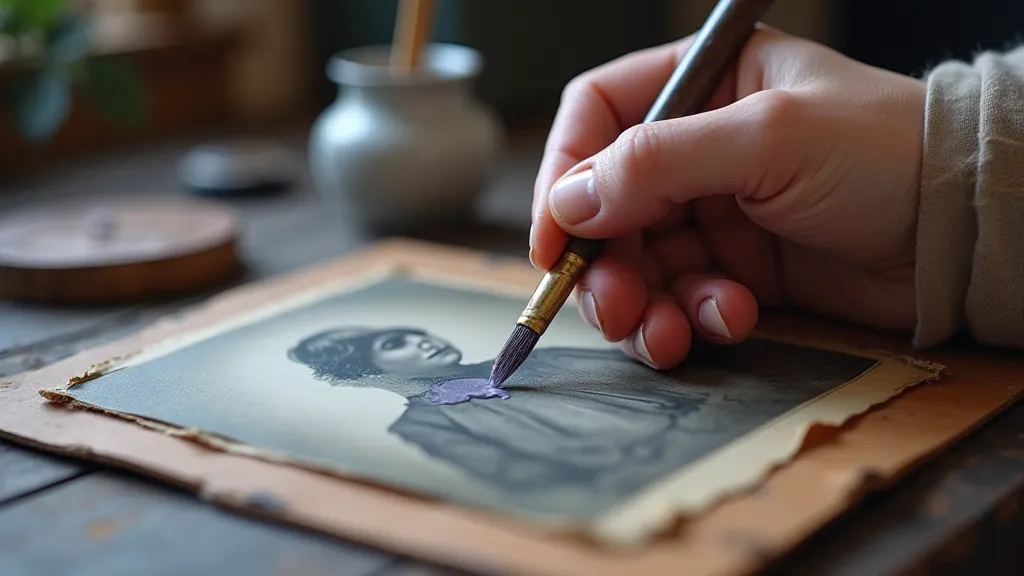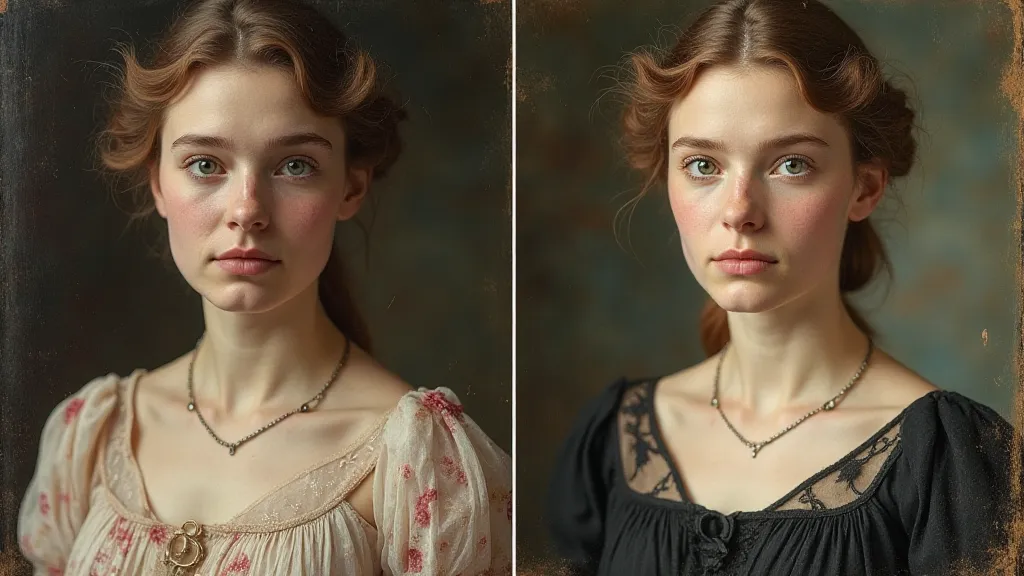The Lavender Bloom of Remembrance: Mourning, Color, and Victorian Sentiment
The Victorian era – a period often associated with somber black attire and rigid social structures – was, paradoxically, a time of profound emotional expression, meticulously codified and often communicated through subtle visual cues. Nowhere is this more evident than in the realm of photography, particularly the delicate art of hand-tinting. We often think of Victorian photography as strictly monochrome, a stark reflection of the prevailing aesthetic. Yet, the addition of color, painstakingly applied by hand, unlocked a hidden layer of meaning, imbued images with sentiment, and whispered tales of loss, love, and remembrance. This article delves into the evocative use of color, focusing on the poignant symbolism of lavender, in Victorian mourning photography and its intimate connection to the era’s complex grief rituals.
My own fascination with this art form began with a dusty box discovered in my grandmother’s attic. Inside, nestled amongst yellowed letters and faded ribbons, were several tintype portraits – ghostly images of individuals I’d never known, their faces brought to life by the subtle blush of rose on their cheeks, the gentle green of their clothing, and, most striking of all, the recurring presence of lavender hues in the backgrounds and accessories.
The Rise of Hand-Tinting and its Purpose
Early photographic processes, such as the daguerreotype and ambrotype, produced inherently monochrome images. While undeniably beautiful, they lacked the vibrancy and emotional depth that many desired. Enter hand-tinting, a labor-intensive process that involved applying pigments – usually oil paints or aniline dyes – directly onto the photographic print. This wasn't just about adding color; it was about conveying meaning. Victorian society placed immense importance on appearances and carefully orchestrated expressions of emotion. Photography, newly accessible to the middle class, became a vital tool in preserving memories and communicating social standing. The addition of color allowed for a richer, more nuanced portrayal of the subject, transforming a simple portrait into a miniature masterpiece.

Lavender: A Color Steeped in Victorian Grief
While reds, yellows, and greens found their place in Victorian tinting, lavender held a particularly significant and deeply resonant role, especially within the context of mourning practices. Queen Victoria’s prolonged and very public grieving following the death of her husband, Prince Albert, in 1861, profoundly impacted Victorian society. She wore black for the rest of her life, and this dictated much of the mourning fashion and customs of the era. Yet, amidst the sea of black, subtle hues like mauve, lilac, and lavender gradually emerged as acceptable colors for those in mourning, reflecting a gradual shift in the intensity of grief and the passage of time.
Lavender, in particular, represented a complex blend of emotions. It symbolized remembrance, humility, and grace. Its delicate nature contrasted sharply with the stark black of mourning attire, suggesting a softening of grief, a gradual return to life, but always tempered by the shadow of loss. In hand-tinted portraits, lavender could appear in a variety of ways: in the background, softening the image and creating a sense of ethereal sadness; adorning a woman’s shawl or ribbon, signifying her status as a bereaved individual; or even subtly outlining facial features, creating a spectral, otherworldly effect.
The choice of lavender wasn't arbitrary. It was a carefully considered act of visual communication, a nonverbal expression of deep personal sorrow. Photographers, often skilled artisans themselves, understood the power of color and its ability to evoke specific emotions. They worked closely with their clients, carefully interpreting their desires and translating them into visual form. The resulting images were not mere representations of reality; they were carefully constructed narratives of grief and remembrance.
The Craftsmanship Behind the Bloom
The process of hand-tinting was incredibly demanding, requiring a steady hand, keen eye for detail, and a deep understanding of color theory. Photographers often employed skilled colorists who specialized in this particular skill. They would begin by carefully examining the photograph, identifying areas where color would enhance the image's emotional impact. Then, using fine brushes, they would apply the pigments, often in multiple layers, to achieve the desired effect. The entire process could take hours, even days, depending on the complexity of the image.
The materials used were also crucial to the final result. Oil paints provided richness and permanence, while aniline dyes offered a wider range of colors and a more delicate application. However, aniline dyes were notoriously unstable and prone to fading over time, contributing to the ephemeral quality of many hand-tinted photographs.

Beyond Lavender: A Spectrum of Victorian Sentiment
While lavender was particularly poignant in mourning portraits, other colors played important roles in conveying different emotions. Rose pink often symbolized love and affection, while green represented hope and renewal. The strategic use of these colors, combined with the subtle nuances of light and shadow, transformed a simple photograph into a powerful visual narrative.
Analyzing these hand-tinted portraits offers a unique window into the Victorian psyche. They reveal a society grappling with loss, expressing grief through carefully constructed visual codes, and seeking solace in the beauty of art. These are not static images; they are living documents, whispering tales of love, loss, and remembrance, each delicate hue a testament to the enduring power of human emotion.
Preserving the Legacy: Collecting and Restoration
Today, hand-tinted Victorian photographs are highly prized by collectors and historical photography enthusiasts. They offer a tangible link to a bygone era, a chance to connect with the individuals who lived and loved and grieved in a world vastly different from our own. However, these delicate images are also vulnerable to damage and deterioration. Proper storage and handling are essential to preserving their legacy for future generations.
Restoration efforts, when undertaken by skilled professionals, can help to stabilize and enhance the appearance of faded or damaged tinting. However, it’s crucial to approach restoration with caution, respecting the original artwork and avoiding any irreversible alterations. The goal is not to create a "perfect" image, but to preserve the integrity and historical significance of the original piece.

The lavender bloom of remembrance in Victorian photography is more than just a color; it's a symbol of an era’s complex emotions, a testament to the artistry of hand-tinting, and a poignant reminder of the enduring power of human connection. By appreciating the nuances of these delicate images, we can gain a deeper understanding of the Victorian era and the timeless beauty of human expression.





